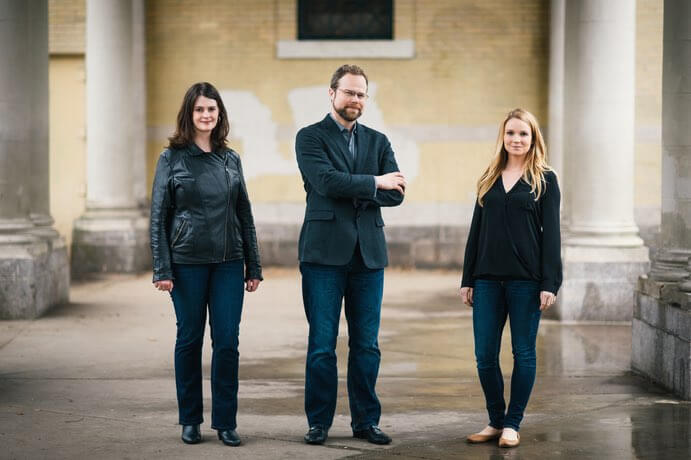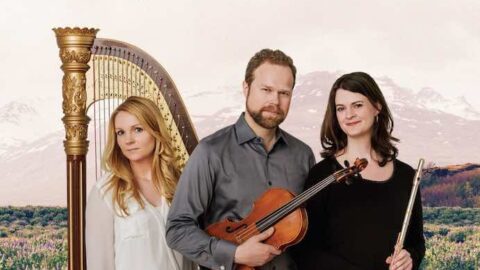New York based Hat Trick Trio (April Clayton, flute, David Wallace, Viola, and Kristi Shade harp) was formed to “broaden the flute, viola, harp repertoire and to showcase its individual and collective strengths.” The trio’s debut CD Garden of Joys and Sorrows on Bridge records does just that. It succeeds by reaching back to the early 20th century for some of the earliest works written for that combination of instruments, then pairing them with contemporary works, including a work commissioned by the trio.
Debussy’s Sonata for Flute, Viola and Harp from 1915, the center of this program, evokes an interesting question. Was the work so far ahead of its time that it sounds contemporary even today, or has contemporary music gone back to embrace and celebrate its immediate past? Probably a subject for a doctoral dissertation or two, I am inclined to say it is a little of both. Debussy’s use of nontraditional scales, intense chromaticism, lush harmonies, and his flexible rhythms and forms expanded the musical palate, taking European music in a new and untried tradition. As well, today’s composers, growing up with rock and jazz in their many forms, mixed media, and a more open and experimental academic environment feel free to explore and absorb whatever sounds or colors needed to express their musical thoughts. If that means evoking the sounds and colors of Debussy, so be it.
Hat Trick’s recording of the mother of the flute/viola/harp repertoire uses the recently published Carl Fischer edition, which follows all of Debussy’s original indication. Many of Debussy’s original markings were omitted during the work’s previous editions, making this recording instantly invaluable to devotees of this work. Hat Trick handles the dreamy impressionism with care and voluptuous expression. The crisp sonics make this a clearer reading than many others allowing the listener to explore and appreciate Debussy’s skillful contrasting and blending timbres of the instruments.

If the Debussy Sonata is the mother, then Fellow Frenchman Theodore Dubois’ short, exquisite Terzettino from 1905 must be the grandmother, predating the Debussy by a decade. Since it was premiered at the Paris Conservatory, it is likely that Debussy knew the work. How much it influenced his sonata is unknown. A charming piece, lovingly performed, serving as a history lesson and a contrast to the more impressionistic modern works.
The Toru Takemitsu work referenced above, And Then I Knew ’twas Wind (1992), pays homage to Debussy’s sonata, thus they are frequently paired in recordings. The work is also literary-inspired, taking its title and liquid sound world from an Emily Dickinson poem “Like rain it sounded till it curved, And then I knew ’twas wind.” The work actually quotes the Debussy sonata both directly and obliquely before infusing the work with the composer’s trademark sensuous and gently expressive sound. Compared to the reference, but now out of print recording on DG by Patrick Gallois, Fabrice Pierre, and Pierre-Henri Xuereb, Hat Trick takes the work a shade faster and a bit sharper edged, perhaps due to the newer, clearer sonics, but certainly holds its own.
Submerged (2013) composed by Uruguayan-American composer Miguel del Aguila was written for and commissioned by the Hat Trick Trio. The work is the most explicitly programmatic composition on the program. The lively and colorful work follows the surrealist poem “Yo en el fondo del mar” (Me at the bottom of the sea) by Argentinian poet Alfonsina Storni. References to the sea, Argentinian rhythms and instruments abound. Lively and even a bit light-hearted, Submerged is also tinged with echoes of tragedy and the power of the sea, evoking Storni’s fascination with the sea and her suicide by drowning.

A dancing introduction opens the work soon to abruptly end with sharp chords from the harp taking us down to the bottom of the sea. Relish the exceptional variety of sounds del Aguila coaxes from the trio, vividly bringing life to its magical world of cheeky octopi, golden fish bearing flowers of coral, and frolicking mermaids. With the poem’s words “above my head glow in the twilight the prickling pins of the sea,” the music from the introduction returns as a whirling coda, taking us back to reality.
Sofia Gubaidulina’s Garden of Joys and Sorrows is the starkest and most abstract work on the album, despite the literary connection to the poem Garten von Freuden und Traurigkeiten by Francisco Tanzer. Garden of Joys and Sorrows is an extensive exploration of the instruments. The harp has a particularly percussive role, underpinning the mostly melodic viola and flute. As with many of Gubaidulina’s works, echoes of the east and Russian Orthodox music can be heard in the melismatic flute. This is a well-turned performance of a soft, meditative, maybe a bit elusive, yet colorfully satisfying work. Hat Trick handles the demands with aplomb as they do throughout the program. Immediately following Garden of Joys and Sorrows, the CD ends with a recitation of the Tanzer poem in German, expressively and clearly read by Aine Zimmerman. The composer suggests the poem be read as part of any performance.
One definite minus with this otherwise well recorded CD is the inadequate program notes. A program of new music always benefits from insights into the music’s meaning and structure by the composer or performers. While much ink is given to the Debussy, the others are given shorter thrift. The translations of the various literary inspirations, and in the case of Submerged, the original Spanish were welcome, often providing the best clues to the music’s meaning. Hat Trick takes their respective instruments on quite a ride on this generously programmed CD. Anyone curious to explore the rare flute, viola, and harp literature would be wise to check out this album.
























